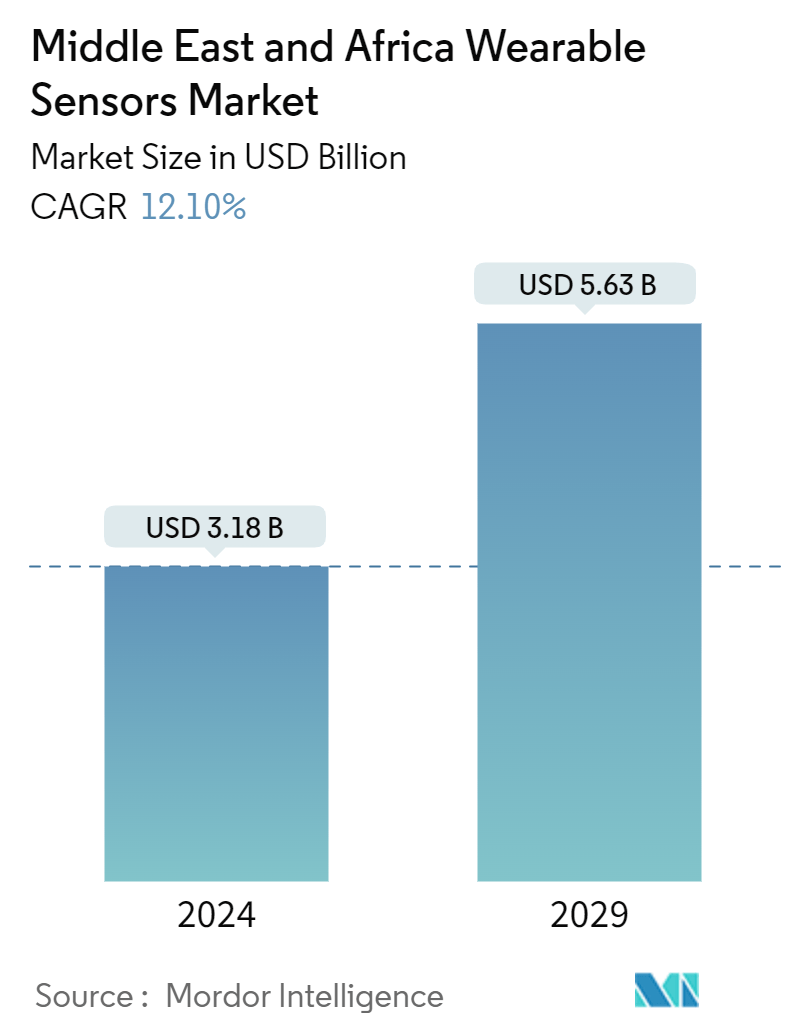Market Size of Middle East And Africa Wearable Sensors Industry

| Study Period | 2019 - 2029 |
| Base Year For Estimation | 2023 |
| Market Size (2024) | USD 3.18 Billion |
| Market Size (2029) | USD 5.63 Billion |
| CAGR (2024 - 2029) | 12.10 % |
| Market Concentration | Medium |
Major Players
*Disclaimer: Major Players sorted in no particular order |
Middle East And Africa Wearable Sensors Market Analysis
The Middle East And Africa Wearable Sensors Market size is estimated at USD 3.18 billion in 2024, and is expected to reach USD 5.63 billion by 2029, growing at a CAGR of 12.10% during the forecast period (2024-2029).
Wearable sensors are gaining popularity in digital systems like health monitoring systems due to ongoing developments in modern technologies and miniature circuits. Wearable technology generally includes sensors and wireless connections, allowing users to monitor, track, and analyze data. Various accessories, including wristbands, eyeglasses, headphones, and smartphones, are combined with these wearable sensor systems.
- Increased spending on consumer electronics, improved lifestyles, and a surge in urbanization have led to a rise in health and safety awareness. With rising disposable incomes, devices like smart wristbands, smartwatches, fitness trackers, VR headsets, activity trackers, sports watches, healthcare applications, and enterprise and industrial applications are gaining tremendous traction. In June 2023, the Uniccon Group launched a highly anticipated VR headset at the GITEX Africa 2023.
- According to the Saudi Arabian Monetary Agency, consumer spending in Saudi Arabia increased to SAR 343,374 million (USD 91.554 billion) in the first quarter of 2022 from SAR 333,555 million (USD 88.936 billion) in the fourth quarter of the previous year. Furthermore, according to the OECD, Israel's economy grew by 4.9% in 2022 and 4% in 2023.
- One significant factor anticipated to drive the wearable sensors market during the forecast period is the growing elderly population. Over the coming decades, Saudi Arabia's aging population will rapidly grow.
- According to UN projections, the senior population in Saudi Arabia will rise from 5.6% in 2017 to 22.9% by 2050. Furthermore, according to the UN Population Fund, Egypt is undergoing a demographic transition as the number of people over 60 is predicted to more than double from 8.4 million (8% of the overall population) to 22 million between 2020-2050 (14%).
- The market is currently flooded with smart, Internet-connected products, and the number is expanding quickly. The primary condition for enabling adequate sensor data and information exchange is standardization. A few businesses have developed standards for sensor communication.
- The OGC's Sensor Web Enablement (SWE) measures satisfy the need for improved sensor connectivity in highly complicated and basic applications. Thousands of geospatial applications that use the OGC or other standards may easily incorporate this data due to the SWE standards. Interoperability problems are also brought on by the absence of universal standards for sensor communication.
- With the growing propensity of consumers toward smart wearables, the prices of instruments are also soaring, along with the increasing cost of components, thereby limiting adoption in the market. Smartwatches and fitness trackers have low-cost components that drive significant attention from consumers. However, with the increase of technology, other devices such as footwear, eyewear, and body wear products are highly priced and have lower adoption rates. Most wearable technologies are currently highly priced, negatively impacting adoption in the market.
- The ongoing conflict between Russia and Ukraine will significantly impact the electronics industry. The competition has already exacerbated the semiconductor supply chain issues and the chip shortage that have affected the industry for some time. The disruption may come in the form of volatile pricing for critical raw materials such as nickel, palladium, copper, titanium, aluminum, and iron ore, resulting in material shortages. This would obstruct the manufacturing of wearable sensors.
Middle East And Africa Wearable Sensors Industry Segmentation
Wearable sensors monitor health and supply clinically important data for treatment. They can be integrated into wearable devices or used directly on the body. Owing to the development of sensor technologies, wearables now have a greater capacity for measurement. As a result, customers better understand themselves and are better equipped to alter their lifestyles.
The Middle East and African wearable sensors market is segmented by type (temperature, pressure, image/optical, motion, and other types of sensors), application (health and wellness, safety monitoring, sports and fitness, and other applications), and country (United Arab Emirates, Saudi Arabia and the Rest of Middle East and Africa). The market sizes and forecasts are provided in terms of value (USD) for all the above segments.
| By Type | |
| Temperature | |
| Pressure | |
| Image/Optical | |
| Motion | |
| Other Types of Sensors |
| By Application | |
| Health and Wellness | |
| Safety Monitoring | |
| Sports and Fitness | |
| Other Applications |
| By Country | |
| United Arab Emirates | |
| Saudi Arabia |
Middle East And Africa Wearable Sensors Market Size Summary
The Middle East and Africa wearable sensors market is experiencing robust growth, driven by advancements in digital systems and miniature technologies. These sensors, integral to wearable technology, are increasingly incorporated into devices like smartwatches, fitness trackers, and VR headsets, enabling users to monitor and analyze health data. The market's expansion is fueled by rising consumer electronics spending, improved lifestyles, and heightened health awareness due to urbanization. The growing elderly population in countries like Saudi Arabia and Egypt further propels demand, as wearable sensors offer vital health monitoring capabilities. However, the market faces challenges such as high costs of advanced wearable devices and supply chain disruptions affecting component availability.
In the healthcare sector, wearable sensors are gaining traction for their ability to monitor vital signs and enhance patient care. The introduction of stylish and health-focused wearables by companies like Huawei and the collaboration between BioIntelliSense and Mubadala Health highlight the sector's commitment to integrating advanced technology in healthcare. The market is also witnessing strategic partnerships aimed at developing innovative solutions, as seen with LifeQ and AAIC Investment. Despite the high cost of some wearable technologies, the increasing prevalence of health concerns and the rise in smartphone users in the region present significant growth opportunities. The market remains semi-consolidated, with key players like STMicroelectronics and Infineon Technologies leading the charge in product development and strategic collaborations.
Middle East And Africa Wearable Sensors Market Size - Table of Contents
-
1. MARKET INSIGHTS
-
1.1 Market Overview
-
1.2 Industry Attractiveness - Porter's Five Forces Analysis
-
1.2.1 Bargaining Power of Suppliers
-
1.2.2 Bargaining Power of Buyers
-
1.2.3 Threat of New Entrants
-
1.2.4 Threat of Substitutes
-
1.2.5 Intensity of Competitive Rivalry
-
-
1.3 Value Chain Analysis
-
1.4 Assessment of the Impact of Macroeconomic Trends on the Market
-
-
2. MARKET SEGMENTATION
-
2.1 By Type
-
2.1.1 Temperature
-
2.1.2 Pressure
-
2.1.3 Image/Optical
-
2.1.4 Motion
-
2.1.5 Other Types of Sensors
-
-
2.2 By Application
-
2.2.1 Health and Wellness
-
2.2.2 Safety Monitoring
-
2.2.3 Sports and Fitness
-
2.2.4 Other Applications
-
-
2.3 By Country
-
2.3.1 United Arab Emirates
-
2.3.2 Saudi Arabia
-
-
Middle East And Africa Wearable Sensors Market Size FAQs
How big is the Middle East And Africa Wearable Sensors Market?
The Middle East And Africa Wearable Sensors Market size is expected to reach USD 3.18 billion in 2024 and grow at a CAGR of 12.10% to reach USD 5.63 billion by 2029.
What is the current Middle East And Africa Wearable Sensors Market size?
In 2024, the Middle East And Africa Wearable Sensors Market size is expected to reach USD 3.18 billion.

